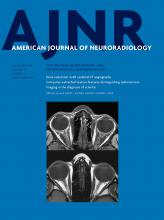Abstract
BACKGROUND AND PURPOSE: The novel technique of 4D CTA for dynamic assessment of the intracranial vessels has a greater radiation burden than conventional CTA. Previous descriptions of the technique used a fixed-duration exposure protocol. This study examines the potential for dose reduction by individualizing exposure time to patient physiology by the use of time-enhancement curve techniques as previously applied in CT angiography and venography.
MATERIALS AND METHODS: 4D-CTA examinations performed at our institution were retrospectively reviewed. Scan protocols used a test-bolus scan with either a subjective estimate of the main acquisition timing (estimated-duration method) or a quantitative measure (measured-duration method). The estimated-duration method used peak arterial enhancement to determine the start of exposure, with the duration chosen at the radiologist's discretion. The measured-duration method used arterial and venous time-enhancement curves to determine exposure start and duration. Exposure duration, study adequacy, quality score, and maximum venous enhancement were compared among groups.
RESULTS: One hundred fifty-one examinations used the estimated-duration method, and 53 used measured-duration. The measured-duration method used a shorter exposure time (10 versus 15.8 seconds; P < .001). There was no statistically significant difference in the study adequacy rate, subjective quality score, or maximum venous enhancement. The radiation dose was reduced by 51% in the measured-duration method (3021 mGy × cm, 6.9 mSv, versus 1473 mGy × cm, 3.4 mSv). Both methods showed good agreement with DSA (κ = 0.88 for estimated-duration, κ = 1.0 for measured duration).
CONCLUSIONS: Exposure time in 4D-CTA can be reduced with dual time-enhancement curves to match exposure to physiology without degrading study adequacy or quality.
ABBREVIATIONS:
- tOA
- time to onset of arterial enhancement
- tPA
- time delay to peak arterial enhancement
- tPV
- time to peak venous enhancement
- © 2016 by American Journal of Neuroradiology












